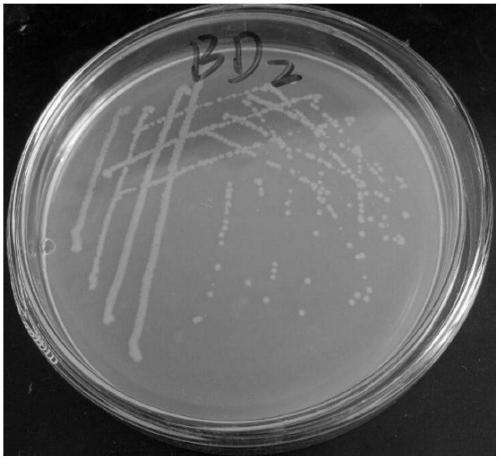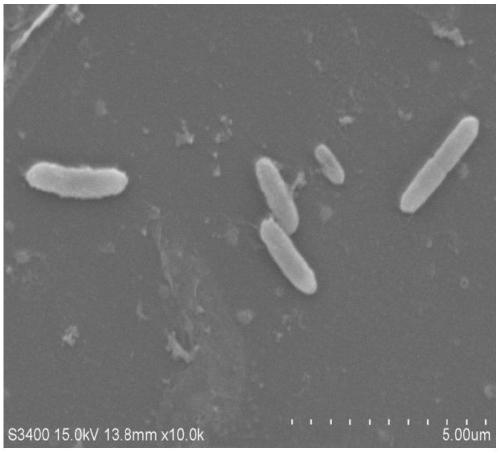Klebsiella sp. strain, pyridine biodegradation agent as well as preparation method and application of pyridine biodegradation agent
A technology of Klebsiella and Lebsiella strains, applied in the biological field, can solve the problems of high cost of pyridine, insignificant effect, and salt-tolerant pyridine-degrading bacteria, and achieve good application prospects
- Summary
- Abstract
- Description
- Claims
- Application Information
AI Technical Summary
Problems solved by technology
Method used
Image
Examples
Embodiment 1
[0042] A high-efficiency pyridine-degrading strain, which is classified as Klebsiella sp. BD2, was deposited in the China Center for Type Culture Collection on October 17, 2018, and the preservation number is CCTCC NO: M 2018685 ; The depository address is Wuhan University, Hubei Province, China.
[0043] The bacterial strain BD2 of the present invention is obtained by screening and separating water samples taken from a wastewater treatment pool of a pesticide and chemical enterprise in Changsha.
[0044] The specific screening methods are:
[0045] (1) Collect 3 samples of water from the wastewater pool of a pesticide chemical factory in Changsha, each sample is about 500ml, and bring it back to the laboratory after marking.
[0046] (2) Get 1ml of the supernatant of the water sample in the wastewater treatment pond, dilute it with concentration gradient dilution method, get 10 -5 、10 -6 、10 -7 1ml of the dilution solution of the three gradients is evenly spread on the py...
Embodiment 2
[0051] A kind of pyridine biodegradation bacterial agent, its preparation method is:
[0052] (1) Take out the Klebsiella BD2 strain stored at -20°C LB solid slant or -80°C ultra-low temperature 70% glycerol cryopreservation, place it at room temperature, then inoculate it into 50 mL of LB liquid medium and culture it on a shaking table for 24 hours, shake The bed speed is 180r / min to complete the activation of the strain.
[0053] (2) Take 2 ml of the activated bacterial liquid into 100 ml of inorganic salt culture medium with a pyridine concentration of 100 mg / L and a pH of 7.5, and culture it for 24 hours at a shaker speed of 180 r / min at 30°C to obtain a bacterial liquid; Figure 5 In the process of cultivating for 32h, the growth curve of the strain is obtained from Figure 5 It can be seen that the growth of the strain reached the maximum at 24h.
[0054] (3) Take 2ml of the bacterial solution in step (2) and put it in 100ml of inorganic salt culture medium with a pyri...
Embodiment 3
[0056] To investigate the salt tolerance of pyridine biodegradation bacteria agent. Get the pyridine biodegradation bacterial agent of 1ml embodiment 2 and add to salinity and be 0% (W / V), 0.5% (W / V), 1% (W / V), 1.5% (W / V), 2% (W / V), 2.5% (W / V) MS medium, shaker speed 180r / min, pH7.0, pyridine concentration 100mg / L, culture 24h under the condition of 30 ℃, ultraviolet spectrophotometer (600nm) The growth of the strain was measured, and the content of pyridine was determined by high performance liquid chromatography.
[0057] See results Image 6 ,from Image 6 As can be seen in the figure, when the salinity is between 0% and 1.5%, the growth amount of the bacterial strain BD2 changes little, and when the salinity is greater than 1.5%, the growth amount drops significantly, and the growth of the bacterial strain is inhibited. Has a certain salt tolerance.
PUM
 Login to View More
Login to View More Abstract
Description
Claims
Application Information
 Login to View More
Login to View More - R&D
- Intellectual Property
- Life Sciences
- Materials
- Tech Scout
- Unparalleled Data Quality
- Higher Quality Content
- 60% Fewer Hallucinations
Browse by: Latest US Patents, China's latest patents, Technical Efficacy Thesaurus, Application Domain, Technology Topic, Popular Technical Reports.
© 2025 PatSnap. All rights reserved.Legal|Privacy policy|Modern Slavery Act Transparency Statement|Sitemap|About US| Contact US: help@patsnap.com



